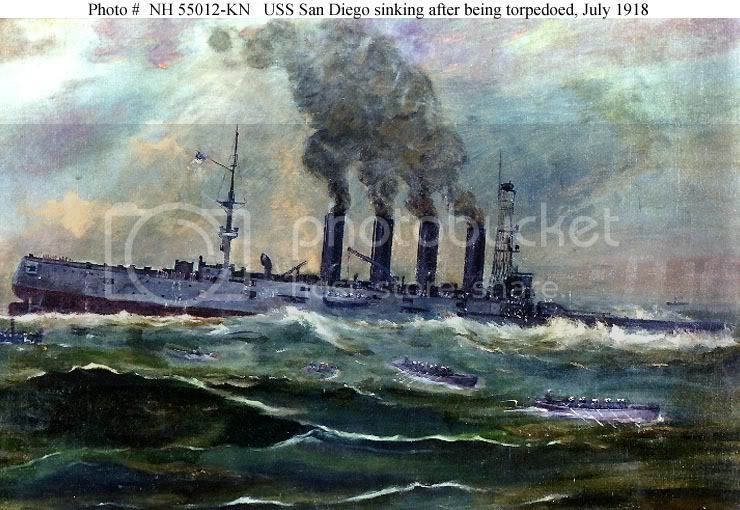The events of the sinking of the USS San Diego on 19 July 1918
A painting by Francis Muller, 1920.
It depicts the ship siking of Fire Island, New York

On June 15th, the German submarine, U-156, left its home port with 77 crewmen. It passed through the North Sea, around the north end of the British Isles and into the Atlantic Ocean towards New York's Long Island where she laid mines in the area where the San Diego was lost. On its cruise to North America, the U-156 sank 36 vessels and is credited with sinking the USS San Diego.
On 19 July 1918, bound from Portsmouth, N.H., San Diego steams to New York to meet up with a transatlantic convoy. The day dawned warm and hazy with the cruiser steaming along the South Shore in state-of-battle readiness.
At about 10 a.m., a lookout spotted a small object moving on the surface. Thinking it might be a submarine periscope, the gun crews fired several rounds until the target disappeared. It was the first time the San Diego's guns had been fired at a suspected enemy. The ship was cutting through the calm sea at more than 15 knots when it was rocked by an explosion, and a column of water erupted along the port side. The San Diego immediately listed 10 degrees. It was 11:05 a.m.
Most the crew of the San Diego felt a dull thud which originated from the port side engine room. The explosion blew a hole in the hull at the port engine room, killing two seamen instantly. Another crewman oiling the port propeller shaft was never seen again. Just after this occurred, residents in Fire Island's Point O'Woods heard a rumbling noise at sea. The noise was the San Diego being jarred to the keel by a violent explosion on the port side just aft of the forward port engine room, later established as contact with a floating mine. The crew that worked in this area must have experienced a large explosion as bulkheads were smashed in. The ocean rushed in and flooding was unstoppable and within 28 minutes the USS San Diego gently rolled over and was gone. Three men died at the instant of the explosion, three died while in the water, and three were injured. Captain Christy rang for full speed on the undamaged starboard engine and turned toward shore, hoping to beach the ship. But the rush of water into the hole flooded the remaining engine and left the San Diego without power, preventing an SOS message.
Although the U-156 was already off the New England coast, crew members again thought they saw a periscope and began firing at it.
C.E. Sims, an 18-year-old seaman, wrote maritime historian Henry Keatts years later that he heard the explosion while he was on the bridge. "I looked aft and saw a huge column of smoke about a hundred feet high. There was no panic. There was an officer who stood on the ladder with his hand on his holster. I remember he said 'If anyone jumps before abandon ship is given, I'll shoot him.'"
When the captain gave the order, the crew struggled to launch the lifeboats manually. As the ship heeled, the smokestacks broke loose, one of them fatally crushing a sailor in the water. Another crew member died when a life raft fell on his head. A sixth sailor drowned after becoming trapped inside the crow's nest.
Christy dispatched a small boat to shore to contact the Navy. Two hours later, it sailed through the surf at Point O'Woods. Rescue vessels were soon on their way to help survivors and search for the sub. The ships dropped depth charges on a target that turned out to be the San Diego.
Capt. Harley Christy jumped from the tilting bridge, descended a ladder to the deck, slid down a rope and then walked over the rolling hull as if he were a lumberjack on a floating log, stopped for a moment to salute his vessel, then dropped eight feet into the Atlantic. In keeping with tradition, the captain was the last man to leave his ship. As a lifeboat picked up Christy, the crew members in boats, on rafts or in the water cheered their skipper. And as the San Diego sank stern first into the flat sea, the men sang The Star Spangled Banner and My Country 'Tis of Thee.
The Fire Island Radio Station telephoned stating that they had picked up a very faint SOS from a naval vessel. The Navy Yard was notified and boats were sent out from Oak Island and Fire Island. Over 1100 men were in the water clinging to wreckage when the boats arrived. Four officers and 28 men were carried to the shore of Point O'Woods and the others were transported to Hoboken, NJ. A few months later, on its way back to Germany, the U-156 hit a mine between Scotland and Norway. Within a few seconds, the German U-boat, U-156 disappeared from the surface of the ocean.
Credit and acknowledgement to Joe Hartwell
Cheers
Sean









